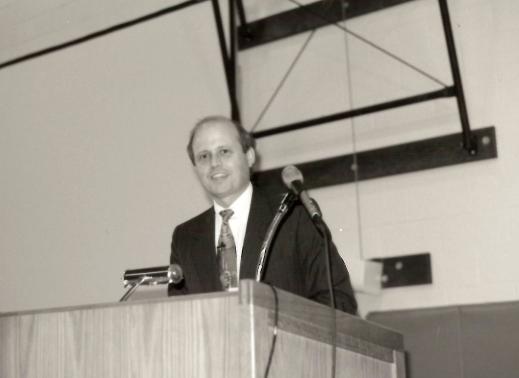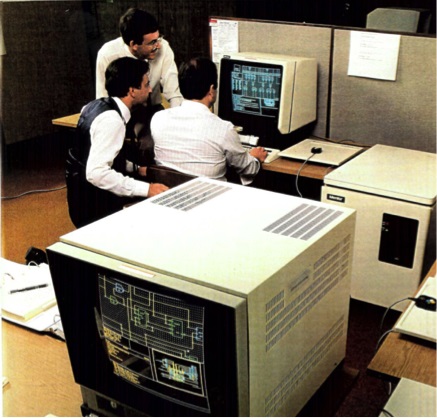
This is the fourteenth in the series of “20 Questions with Wally Rhines”
I joined Mentor Graphics (now Mentor, A Siemens Business), in late 1993. Tom Engibous, one of my direct reporting people at TI, was promoted to replace me as head of the Semiconductor business of TI and I moved on to what I knew would be a real challenge, the rescue of an EDA company that had committed to a strategy that was likely to fail; I knew all this because I was a large customer for Mentor at TI. But my wife thought that Portland would be a good place to raise our very young children and Jerry Junkins, the CEO of TI, made it clear to me that any succession to his role wouldn’t happen for at least ten years because of his own career plans.
I came to Mentor with an optimistic view. After all, most companies that have failed product generations can quickly shift to other innovations they have on the shelf and re-generate their momentum. Not so with Mentor’s Version 8.0 Falcon (later referred to as Version Late dot Slow). There wasn’t a lot on the shelves to build upon and almost everyone in the company had been moved to the Falcon project to try to save it. But the shelves were not totally bare.
My first interest at Mentor was emulation. After all, I knew that Mentor had the best emulation technology in the industry, having visited there to observe it before. When I arrived at Mentor and asked about it, everyone started checking his shoe polish. Unfortunately, Mentor had sold its leading emulation technology, along with the patents, to QUICKTURN, leaving only a very limited ability to compete.
I then turned to physical verification. After all, I had signed the contracts for Mentor to OEM TI’s physical verification software while I was at TI, and it had been a reasonable recovery from Mentor’s loss of Dracula (their OEM solution) when Cadence acquired ECAD and terminated Mentor’s OEM agreement. TI was not interested in extending the OEM arrangement with Mentor to the next generation so we bought out their rights and in January 1994, we had a big kickoff meeting to develop the next generation of physical verification, headed by Laurence Grodd for the physical verification and Koby Kresh for the Logic to Schematic verification. In addition to the fact that Laurence was brilliant, we had the benefit that he had maintained a database of designs that were verified using “Checkmate”, the Mentor name for the product we OEM’d from TI. Laurence could handle hundreds of variants in design style. He proceeded to innovate innumerable approaches to physical verification including selective promotion and other things that are routine today; unfortunately, Mentor didn’t file any patents. So ISS, a company in North Carolina that was ultimately acquired by AVANTI, adopted many of these approaches, including hierarchical forms of analysis.
 Internal politics were also a factor, as they always are in large companies. Mentor’s custom IC layout product, IC Station, was in a battle to beat Cadence’s product, Virtuoso. Our physical verification capability in IC Station came from Laurence, was called “IC Verify”, and was clearly superior to competition. So why would we sell it stand-alone to competitors using Virtuoso? Subsequently, a copy of “Calibre” was sneaked out to AMD and their designers became excited by it. Meanwhile, Mentor’s products that had evolved from the TI OEM continued to evolve and Intel became a major customer. The war had begun. At the next DAC, a decision was made to display the new “Calibre” capability and that was a decisive move, undercutting the roadmap that Intel was expecting. While the Intel surprise was upsetting for some in our sales force, Calibre clearly ushered in a whole new generation of physical verification.
Internal politics were also a factor, as they always are in large companies. Mentor’s custom IC layout product, IC Station, was in a battle to beat Cadence’s product, Virtuoso. Our physical verification capability in IC Station came from Laurence, was called “IC Verify”, and was clearly superior to competition. So why would we sell it stand-alone to competitors using Virtuoso? Subsequently, a copy of “Calibre” was sneaked out to AMD and their designers became excited by it. Meanwhile, Mentor’s products that had evolved from the TI OEM continued to evolve and Intel became a major customer. The war had begun. At the next DAC, a decision was made to display the new “Calibre” capability and that was a decisive move, undercutting the roadmap that Intel was expecting. While the Intel surprise was upsetting for some in our sales force, Calibre clearly ushered in a whole new generation of physical verification.
The critical role at this time came to Brian Derrick, GM of the Physical Verification Division. Brian did something very innovative, and probably forbidden in most large companies. Brian worked directly with Danny Perng, a salesman in Taiwan who was interested in focusing on Calibre for the foundries, TSMC and UMC. Because our sales force knew that TSMC and UMC wouldn’t pay much for tools, the sales and support resources in Taiwan were insufficient to drive a foundry campaign. So without permission, Brian hired his own sales force to complement Danny’s effort. These specialists from the product division were able to convince the TSMC engineers, and later those at UMC, GLOBALFOUNDRIES, etc., that Calibre was superior to competitive approaches.
Simultaneously, Brian’s team concluded that optical proximity correction would be the next important extension of physical verification. Presim, a startup based in Portland, Oegon, was the leader and they had captured the Intel account. Not to be defeated, Brian found the leading experts in the technology (going to UC. Berkeley to find OPC Technology Inc. and hiring Nick Cobb to head up the development). These strategic moves created the basis for Mentor’s #1 position today in both physical verification and resolution enhancement.
Of course there were many more battles to win (and lots of fun yet to be experienced). Whenever I ask successful people in technology, including CEO’s, about the most enjoyable part of their careers, they almost always point to a period when they worked with a group that overcame the impossible and developed a product or capability that changed an industry. Calibre provided just such an experience for many, as did a number of other developments that emerged on Mentor’s path to recovery.
Mentor had undergone lots of problems and had moved from #1 to #3 in a competitive EDA industry. It was clear that we had found areas where we could be the defacto standard: Calibre physical verification, Tessent Design for Test, Expedition PCB Design, Calypto/Catapult high Level Synthesis, Automotive Embedded Electronics, and eight others by the metric provided in the official Gary Smith EDA analyses. Fortunately, Synopsys eventually decided that they didn’t have to do everything; they could pursue new areas that Mentor was not pursuing. That allowed a level of diversification that had not been common in the EDA industry.
And, with that, the EDA industry started to change. Each major EDA company developed specialties, instead of spending all their time trying to take market share from each other. And they all became more innovative. If I could claim one contribution to the EDA industry, it would be this. We are now an industry that looks for capabilities that will help our customers, and then develops (or acquires) those capabilities, rather than just trying to take market share from each other.
The 20 Questions with Wally Rhines Series
Share this post via:





The Quantum Threat: Why Industrial Control Systems Must Be Ready and How PQShield Is Leading the Defense